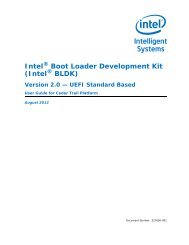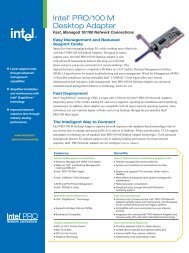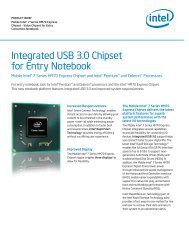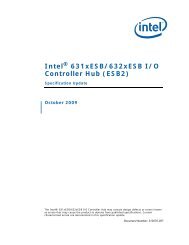mPGA604 Socket Design Guide [pdf] - Intel
mPGA604 Socket Design Guide [pdf] - Intel
mPGA604 Socket Design Guide [pdf] - Intel
Create successful ePaper yourself
Turn your PDF publications into a flip-book with our unique Google optimized e-Paper software.
RINFORMATION IN THIS DOCUMENT IS PROVIDED IN CONNECTION WITH INTEL ® PRODUCTS. NO LICENSE, EXPRESS OR IMPLIED, BYESTOPPEL OR OTHERWISE, TO ANY INTELLECTUAL PROPERTY RIGHTS IS GRANTED BY THIS DOCUMENT. EXCEPT AS PROVIDED ININTEL'S TERMS AND CONDITIONS OF SALE FOR SUCH PRODUCTS, INTEL ASSUMES NO LIABILITY WHATSOEVER, AND INTEL DISCLAIMSANY EXPRESS OR IMPLIED WARRANTY, RELATING TO SALE AND/OR USE OF INTEL PRODUCTS INCLUDING LIABILITY OR WARRANTIESRELATING TO FITNESS FOR A PARTICULAR PURPOSE, MERCHANTABILITY, OR INFRINGEMENT OF ANY PATENT, COPYRIGHT OR OTHERINTELLECTUAL PROPERTY RIGHT. <strong>Intel</strong> products are not intended for use in medical, life saving, life sustaining applications.<strong>Intel</strong> may make changes to specifications and product descriptions at any time, without notice.<strong>Design</strong>ers must not rely on the absence or characteristics of any features or instructions marked "reserved" or "undefined." <strong>Intel</strong> reserves these forfuture definition and shall have no responsibility whatsoever for conflicts or incompatibilities arising from future changes to them.The <strong>mPGA604</strong> socket may contain design defects or errors known as errata, which may cause the product to deviate from published specifications.Current characterized errata are available on request.Contact your local <strong>Intel</strong> sales office or your distributor to obtain the latest specifications and before placing your product order.Copies of documents, which have an order number and are referenced in this document, or other <strong>Intel</strong> literature, may be obtained by calling 1-800-548-4725, or by visiting <strong>Intel</strong>'s Web Site.<strong>Intel</strong> is a trademark or registered trademark of <strong>Intel</strong> Corporation or its subsidiaries in the United States and other countries.Copyright © 2003-2005, <strong>Intel</strong> Corporation. All rights reserved.* Other brands and names may be claimed as the property of others.2 <strong>mPGA604</strong> <strong>Socket</strong>Mechanical <strong>Design</strong> <strong>Guide</strong>
RRevision HistoryRevisionNumberDescriptionDate001 • Initial release of the document. October 2003002 • Updated for 2005 <strong>Intel</strong> ® Xeon products. March 2005Note:Note all revisions may be published.<strong>mPGA604</strong> <strong>Socket</strong> 5Mechanical <strong>Design</strong> <strong>Guide</strong>
RRe-Validation Notice to <strong>Socket</strong> VendorsAny significant change to the socket will require submission of a detailed explanation of the changeat least 60 days prior to the planned implementation. <strong>Intel</strong> will review the modification and establishthe necessary re-validation procedure that the socket must pass. Any testing that is required MUSTbe completed before the change is implemented.Typical examples of significant changes include, but are not limited to, the following: plasticmaterial changes including base material or color; contact changes including base material, platingmaterial or thickness; and design modifications.For details on validation testing requirements, see Section 6.6 <strong>mPGA604</strong> <strong>Socket</strong>Mechanical <strong>Design</strong> <strong>Guide</strong>
R1 Introduction1.1 ObjectiveThis document defines a surface mount, Zero Insertion Force (ZIF) socket intended for workstationand server platforms based on <strong>Intel</strong> microprocessors. The socket provides I/O, power and groundcontacts. The socket contains 604 contacts arrayed about a cavity in the center of the socket withsolder balls/surface mount features for surface mounting with the motherboard. The <strong>mPGA604</strong><strong>Socket</strong> contacts have 1.27mm pitch with regular pin array, to mate with a 604-pin processorpackage. A 604-pin package will be mated with a 603 solder ball socket. The dummy pin is a keythat allows either the 603-pin processor package or the 604-pin processor package to be used in thesame socket.1.2 PurposeTo define functional, quality, reliability, and material (that is, visual, dimensional and physical)requirements and design guidelines of the <strong>mPGA604</strong> <strong>Socket</strong> in order to provide low cost, low risk,robust, high volume manufacturable (HVM) socket solution available from multiple sources.1.3 ScopeThis design guideline applies to all 604-pin ZIF sockets purchased to the requirements of this designguideline.§<strong>mPGA604</strong> <strong>Socket</strong> 7Mechanical <strong>Design</strong> <strong>Guide</strong>
IntroductionR8 <strong>mPGA604</strong> <strong>Socket</strong>Mechanical <strong>Design</strong> <strong>Guide</strong>
R2 Assembled Component andPackage DescriptionThe <strong>mPGA604</strong> socket dimensions and characteristics must be compatible with that of the processorpackage and related assembly components. Processors using flip-chip pin grid array (FC- mPGA4)package technology are targeted to be used with the <strong>mPGA604</strong> socket.The assembled component may consist of a cooling solution (heatsink, fan, and retentionmechanism), and processor package. The processor Thermal/Mechanical <strong>Design</strong> <strong>Guide</strong>linesdocument provides information for designing components compliant with the <strong>Intel</strong> reference design.Relevant processor FC-mPGA4 package and pin-out information is given in the processorElectrical, Mechanical and Thermal Specifications document.§<strong>mPGA604</strong> <strong>Socket</strong> 9Mechanical <strong>Design</strong> <strong>Guide</strong>
Assembled Component and Package DescriptionR10 <strong>mPGA604</strong> <strong>Socket</strong>Mechanical <strong>Design</strong> <strong>Guide</strong>
R3 Mechanical Requirements3.1 AttachmentA retention system needs to isolate any load in excess of 222.41 N, compressive, from the socketduring the shock and vibration conditions outlined in Section 5. The socket must pass themechanical shock and vibration requirements listed in Section 5 with the associated heatsink andretention mechanism attached. <strong>Socket</strong> can only be attached by the 603 contacts to the motherboard.No external (i.e. screw, extra solder, adhesive....) methods to attach the socket are acceptable.3.2 Materials3.2.1 <strong>Socket</strong> HousingThermoplastic or equivalent, UL 94V-0 flame rating, temperature rating and design capable ofwithstanding a temperature of 240°C for 40sec (minimum) typical of a reflow profile for soldermaterial used on the socket. The material must have a thermal coefficient of expansion in the XYplane capable of passing reliability tests rated for an expected high operating temperature, mountedon FR4type motherboard material.3.2.2 ColorThe color of the socket can be optimized to provide the contrast needed for OEM’s pick and placevision systems. The base and cover of the socket may be different colors as long as they meet theabove requirement.3.3 Cutouts for Package RemovalRecessed cutouts are required in the side of the socket to provide better access to the packagesubstrate, and facilitate the manual removal of inserted package (see Section 9).3.4 <strong>Socket</strong> Standoffs Height<strong>Socket</strong> stand off height, cover lead in and cover lead in depth must not interfere with package pinshoulder at worst-case conditions. The processor (not the pin shoulder) must sit flush on the socketstandoffs and the pin field cannot contact the standoffs (see Section 9).<strong>mPGA604</strong> <strong>Socket</strong> 11Mechanical <strong>Design</strong> <strong>Guide</strong>
Mechanical RequirementsR3.5 MarkingsAll markings required in this section must be able to withstand a temperature of 240 ºC for 40seconds (minimum) typical of a reflow profile for solder material used on the socket, as well as anyenvironmental test procedure outlined in Section 5.3.5.1 Name<strong>mPGA604</strong> (Font type is Helvetica Bold – minimum 6 point).This mark shall be molded or Laser Marked into the processor side of the socket housing.Manufacturer’s insignia (font size at supplier’s discretion).This mark will be molded or laser marked into the socket housing. Both marks must be visible whenfirst seated in the motherboard. Any request for variation from this marking requires a writtendescription (detailing size and location) to be provided to <strong>Intel</strong> for approval.3.5.2 Lock (Closed) and Unlock (Open) MarkingsThe universal symbols for ‘Lock’ and ‘Unlock’ are to be marked on the socket in the appropriatepositions. Clear indicator marks must be located on the actuation mechanism that identifies the lock(closed) and unlock (open) positions of the cover as well as the actuation direction. These marksshould still be visible after a package is inserted into the socket.3.5.3 Lot TraceabilityEach socket will be marked with a lot identification code that will allow traceability of allcomponents, date of manufacture (year and week), and assembly location. The mark must be placedon a surface that is visible when mounted on a printed circuit board. In addition, this identificationcode must be marked on the exterior of the box in which the units ship.3.6 <strong>Socket</strong> SizeThe socket size must meet the dimensions as shown in Section 9, allowing full insertion of the pinsin the socket, without interference between the socket and the pin field. The <strong>mPGA604</strong> <strong>Socket</strong> andactuation area must fit within the keep-in zone defined in Section 9.12 <strong>mPGA604</strong> <strong>Socket</strong>Mechanical <strong>Design</strong> <strong>Guide</strong>
RMechanical Requirements3.7 <strong>Socket</strong>/Package Translation During ActuationThe socket shall be built so that the post-actuated package pin field displacement will not exceed1.27 mm. Movement will be along the Y direction. No Z-axis travel (lift out) of the package isallowed during actuation.3.8 Orientation in Packaging, Shipping and HandlingPackaging media needs to support high volume manufacturing.3.9 Contact Characteristics3.9.1 Number of contactsTotal number of contacts: 603.Total number of contact holes: 604.3.9.2 Base MaterialHigh strength copper alloy.3.9.3 Contact Area Plating0.762 µm (min) gold plating over 1.27 µm (min) nickel underplate in critical contact areas (area onsocket contacts where processor pins will mate) is required. No contamination by solder in thecontact area is allowed during solder reflow.3.9.4 Solder Ball Attachment Area Plating3.81 µm (min) Tin/Lead (typically 85+-5Sn/Pb balance).3.9.5 Solder Ball CharacteristicsTin/Lead (63/37 + 0.5% Sn).3.9.6 LubricantsFor the final assembled product, no lubricant is permitted on the socket contacts. If lubricants areused elsewhere within the socket assembly, these lubricants must not be able to migrate to thesocket contacts.3.10 Material and Recycling RequirementsCadmium shall not be used in the painting or plating of the socket.<strong>mPGA604</strong> <strong>Socket</strong> 13Mechanical <strong>Design</strong> <strong>Guide</strong>
Mechanical RequirementsRCFCs and HFCs shall not be used in manufacturing the socket. It is recommended that any plasticcomponent exceeding 25g must be recyclable as per the European Blue Angel recycling designguidelines.3.11 Lever Actuation Requirements• Lever closed direction—right.• Actuation direction called out in Section 9.• 135º lever travel max.• Pivot point in the center of the actuation area on the top of the socket. Section 9.3.12 <strong>Socket</strong> Engagement/Disengagement ForceThe force on the actuation lever arm must not exceed 44N to engage or disengage the package intothe <strong>mPGA604</strong> socket. Movement of the cover is limited to the plane parallel to the motherboard.The processor package must not be utilized in the actuation of the socket. Any actuation must meetor exceed SEMI S8-95 Safety <strong>Guide</strong>lines for Ergonomics/Human Factors Engineering ofSemiconductor Manufacturing Equipment, example Table R2-7 (Maximum Grip Forces).3.13 Visual AidsThe socket top will have markings identifying Pin 1. This marking will be represented by a clearlyvisible triangular symbol (see Section 9).3.14 <strong>Socket</strong> BGA Co-PlanarityThe co-planarity (profile) requirement for all solder balls on the underside of the socket is located inSection 9.3.15 Solder Ball True PositionThe solder ball pattern has a true position requirement with respect to Datum A, B, and C (seeSection 9).3.16 Critical-to-Function DimensionsThe <strong>mPGA604</strong> socket shall accept a 604-pin processor pin field. All dimensions are metric.Asymmetric features are designed to properly align the socket to the motherboard and prevent thesocket from being assembled incorrectly to the motherboard.Critical-to-function (CTF) dimensions are identified in Table 3-1. The CTF values are detailed onthe <strong>mPGA604</strong> socket drawing in Section 9 and take precedence over all values presented in thisdocument. Dimensional requirements identified in the drawing and in Table 3-1 must be met. Thesedimensions will be verified as part of the validation process. Also, supplier will provide and14 <strong>mPGA604</strong> <strong>Socket</strong>Mechanical <strong>Design</strong> <strong>Guide</strong>
RMechanical Requirementsmaintain Critical Process Parameters controlling these CTFs or will provide direct measurements tomeet ongoing quality requirements.Table 3-1. Package Critical-To-Function (CTF) Dimensions<strong>Socket</strong> Length<strong>Socket</strong> WidthDimension<strong>Socket</strong> Height (Interposer surface from MB)Assembled Seating Plane FlatnessBall DiameterTrue Position of Balls (pattern relating)Co-planarity (profile) of BallsActuation Distance (Cover Travel)Through Cavity XThrough Cavity YCover Hole Diameter (Must guarantee ZIF)Cover Hole Countersink Depth (Must guarantee ZIF)Cover Hole Countersink Diameter (Must guarantee ZIF)Cover Hole Virtual Condition (Pattern Locating)Cover Hole Virtual Condition (Feature Relating)Cover Hole Field Depth wrt Seating PlaneCover Thickness in Hole AreaAu ThicknessNi ThicknessAlignment Post Virtual ConditionContact Depth from Seating Plane§<strong>mPGA604</strong> <strong>Socket</strong> 15Mechanical <strong>Design</strong> <strong>Guide</strong>
R4 Electrical Requirements<strong>Socket</strong> electrical requirements are measured from the socked-seating plane of the processor testvehicle (PTV) to the component side of the socket PCB to which it is attached. All specification aremaximum values (unless otherwise stated) for a single socket pin, but includes effects of adjacentpins where indicated. Pin and socket inductance includes exposed pin from mated contact to bottomof the processor pin field.Table 4-1. Electrical Requirements for <strong>Socket</strong>s1 Mat lloop inductance, Loop
Electrical RequirementsRTable 4-2. Definitions (Sheet 2 of 2)4 Maximum Average ContactResistance. Refer to Table 4-1,Item 45 Measurement frequency(s) forcapacitance.6 Measurement frequency(s) forinductance.The max average resistance target is originallyderived from max resistance of each chainminus resistance of shorting bars divided bynumber of pins in the daisy chain. This valuehas to be satisfied at all time. Thus, this is thespec valid at End of Line, End of Life and etc.<strong>Socket</strong> Contact Resistance: The resistanceof the socket contact, interface resistance tothe pin, and the entire pin to the point wherethe pin enters the interposer; gaps included.Capacitively dominate region. This is usuallythe lowest measurable frequency. This shouldbe determined from the measurements donefor the feasibility.Linear region. This is usually found at higherfrequency ranges. This should be determinedfrom the measurements done for the feasibility.4.1 Electrical ResistanceFigure 4-1and Figure 4-2 show the proposed methodology for measuring the final electricalresistance. The methodology requires measuring interposer flush-mounted directly to themotherboard fixtures, so that the pin shoulder is flush with the motherboard, to get the averagedjumper resistance, Rjumper. The Rjumper should come from a good statistical average of 30package fixtures flush mounted to a motherboard fixture. The same measurements are then madewith a package fixture mounted on a supplier’s socket, and both are mounted on a motherboardfixture; this provides the RTotal. The resistance requirement, RReq, can be calculated for each chain aswill be explained later.Figure 4-1. Methodology for Measuring Total Electrical Resistance.Figure 4-2. Methodology for Measuring Electrical Resistance of the Jumper18 <strong>mPGA604</strong> <strong>Socket</strong>Mechanical <strong>Design</strong> <strong>Guide</strong>
RElectrical RequirementsFigure 4-3 shows the resistance test fixtures separately and superimposed. The upper figure is thepackage. The next figure is the baseboard. There are 48 daisy chain configurations on resistance testboard. The bottom figure is the two parts superimposed. Table 4-3 shows these configurations withthe number of pins per each chain and netlist.Figure 4-3. Electrical Resistance Fixtures Superimposed<strong>mPGA604</strong> <strong>Socket</strong> 19Mechanical <strong>Design</strong> <strong>Guide</strong>
Electrical RequirementsR20 <strong>mPGA604</strong> <strong>Socket</strong>Mechanical <strong>Design</strong> <strong>Guide</strong>
RElectrical RequirementsTable 4-3. Resistance Test Fixture Netlist (Sheet 1 of 2)DC Endpoints Edgefingers: Hi Edgefingers: LowDaisyChain# of ©per chain Hi Low +I +V -V -I1 14 AE2 AE16 A94 A93 A118 A1172 14 AE29 AE16 A136 A135 A118 A1173 16 AD1 AD16 A92 A91 A116 A1174 14 AD30 AD16 A138 A137 A116 A1175 14 AC30 AC16 A96 A95 A114 A1176 14 AC30 AC16 A142 A141 A114 A1137 12 AB4 AB16 A98 A97 A112 A1118 14 AB29 AB16 A134 A133 A112 A1119 12 AA5 AA16 A100 A99 A110 A10910 12 AA28 AA16 A132 A131 A110 A10911 10 Y6 Y16 A102 A101 A108 A10712 10 Y25 Y16 A130 A129 A108 A10713 10 AC1 N1 A90 A89 A46 A4514 12 B1 N1 A64 A63 A46 A4515 10 AC2 N2 A88 A87 A48 A4716 12 B2 N2 A66 A65 A48 A4717 10 AB3 N3 A86 A85 A50 A4918 10 C3 N3 A68 A67 A50 A4919 8 AA4 N4 A84 A83 A52 A5120 10 D4 N4 A70 A69 A52 A5121 16 E5 Y5 A72 A71 A120 A11922 14 F6 W7 A74 A73 A104 A10323 14 F7 W7 A76 A75 A104 A10324 14 F8 W9 A78 A77 A106 A10525 12 G9 W9 A82 A81 A106 A10526 16 A1 A16 A62 A61 A42 A4127 14 A30 A16 A18 A17 A42 A4128 14 B3 B16 A60 A59 A40 A3929 14 B30 B16 A14 A13 A40 A3930 12 C4 C16 A58 A57 A38 A3731 14 C29 C16 A20 A19 A38 A3732 12 D5 D16 A56 A55 A36 A3533 12 D28 D16 A22 A21 A36 A3534 10 E6 E16 A54 A53 A44 A4335 10 E25 E16 A24 A23 A44 A4336 14 F9 F23 A80 A79 A28 A2737 14 W23 F23 A128 A127 A28 A2738 14 F24 W24 A26 A25 A126 A12539 14 F25 W24 A2 A1 A126 A12540 16 E26 Y26 A4 A3 A124 A12341 16 E27 Y26 A6 A5 A124 A123<strong>mPGA604</strong> <strong>Socket</strong> 21Mechanical <strong>Design</strong> <strong>Guide</strong>
Electrical RequirementsRTable 4-3. Resistance Test Fixture Netlist (Sheet 2 of 2)DC Endpoints Edgefingers: Hi Edgefingers: LowDaisyChain# of ©per chain Hi Low +I +V -V -I42 16 E28 Y28 A8 A7 A122 A12143 10 D29 N29 A10 A9 A34 A3344 8 AA29 N29 A146 A145 A34 A3345 10 C30 N30 A12 A11 A32 A3146 10 AB30 N30 A144 A143 A32 A3147 12 A31 N31 A16 A15 A30 A2948 12 AD31 N31 A140 A139 A30 A294.2 Determination of Maximum Electrical ResistanceThis section provides a guideline for the instruments used to take the measurements.Note:The instrument selection should consider the guidelines in EIA 364-23A.1. These measurements use a 4-wire technique, where the instruments provide two separatecircuits. One is a precision current source to deliver the test current. The other is a precisionvoltmeter circuit to measure the voltage drop between the desired points.2. These separate circuits can be contained within one instrument, such as a high quality microohmmeter,a stand-alone current source and voltmeter, or the circuits of a data acquisitionsystem.3. Measurement accuracy in Ω is specified as ± 0.1% of reading, or ± 0.1 mΩ, whichever isgreater. The vendor is responsible for demonstrating that their instrument(s) can meet thisaccuracy.4. Automation of the measurements can be implemented by scanning the chains through theedge or cable test connector using a switch matrix. The matrix can be operated by hand, orthrough software.5. Measure R Total for each daisy chain of “package + socket + motherboard” unit.6. Measure R jumper for each daisy chain of 30 “package + motherboard” units. Calculatefor each daisy chain (There is 30 data for each daisy chain).7. For each socket unit, calculateR Req is the average contact resistance for socket pin.22 <strong>mPGA604</strong> <strong>Socket</strong>Mechanical <strong>Design</strong> <strong>Guide</strong>
RElectrical Requirements4.3 InductanceThe bottom fixture for the inductance measurement is a ground plane on the secondary side of themotherboard with all pins grounded. The component side of the socket PCB does not contain aplane. The top fixture is the package, which contains pins that will connect to the socket. Figure 4-4shows the inductance measurement fixture cross-section and the inductance measurementmethodology. The first figure shows the entire assembly. The second figure shows the assemblywithout the socket; the socket-seating plane of the package is directly mounted to the componentside of the socket PCB. This is used to calibrate out the fixture contribution. The materials for thefixture must match the materials used in the processor. Note the probe pad features exist on thetopside of the top fixture, and the shorting plane exists only on the bottom side of the bottom fixture.Figure 4-5 presents the inductance and capacitance fixture design.Figure 4-4. Inductance Measurement Fixture Cross-SectionFigure 4-5. Inductance and Capacitance Fixture<strong>mPGA604</strong> <strong>Socket</strong> 23Mechanical <strong>Design</strong> <strong>Guide</strong>
Electrical RequirementsR4.3.1 <strong>Design</strong> Procedure for Inductance MeasurementsThe measurement equipment required to perform the validation is:• Equipment - HP8753D Vector Network Analyzer or equivalent.• Robust Probe Station (GTL4040) or equivalent.• Probes - GS1250 & GSG1250 Air-Co-Planar or equivalent.• Calibration – Cascade Calibration Substrates or equivalent.• Measurement objects - <strong>Socket</strong>s, Motherboards.Measurement Steps:1. Equipment Setup:a. Cables should be connected to the network analyzer and to the probes using theappropriate torque wrench to ensure consistent data collection every time themeasurement is performed.2. Set VNA:a. Bandwidth = 300KHz – 3GHz with 801 points.b. Averaging Factor = 16.3. Perform Open/Short/Load Calibration:a. Calibration should be performed at the start of any measurement session.b. Create Calibration Kit if necessary for 1 st time.c. Do not perform port extension after calibration.4. Check to ensure calibration successfully performed.5. Measure the inductance of the socket mounted to the motherboard fixture by probing thelocations on the PGA Adapter and socket assembly:a. Call this Lsocket assembly.b. Export data into MDS/ADS or (capture data at frequency specified in item 6 ofTable 4-1).6. Measure the inductance of the PGA Adapter by probing on the pads. Call this Lsandwich:a. Measure 30 units.b. The test board for 30 units must be chosen from different lots. Use 5 different lots, 6units from each lot.c. Export data into MDS/ADS or (capture data at frequency specified in item 6of Table 4-1).d. Calculate L sandwich .e. For each socket unit, calculateLsocket= Lsocket assembly− LsandwichIt means L sandwich will be subtracted from each Lsocket assemblyand the result will becompared with spec value for each individual socket unit.24 <strong>mPGA604</strong> <strong>Socket</strong>Mechanical <strong>Design</strong> <strong>Guide</strong>
RElectrical Requirements4.3.2 Correlation of Measurement and Model Data InductanceTo correlate the measurement and model data for loop inductance, one unit of measured socketassembly (socket and shorted test fixture) and one unit of measured sandwich (shorted test fixture)will be chosen for cross sectioning. Both units will be modeled based on data from cross sectioningusing Ansoft* 3D. The sandwich inductance will be subtracted from socket assembly inductance forboth measured and modeled data. This procedure results in loop inductance for socket contact. Thisfinal result can be compared with the loop inductance from the supplier model for the socket. Ifthere is any difference between them, it will be called the de-embedded correction factor. Addingthe test board to the socket and then eliminating the contribution of the fixture creates this correctionfactor because inductance is not linear.4.4 Pin-to-Pin CapacitancePin-to-pin capacitance shall be measured using configuration 4, with the motherboard not connectedand only the measurements with the package mounted on the socket will be taken. Capture data atfrequency specified in item 5 of Table 4-1.4.5 Dielectric Withstand VoltageNo disruptive discharge or leakage greater than 0.5 mA is allowed when subjected to 360 V RMS.The sockets shall be tested according to EIA-364, Test Procedure 20A, Method 1. The sockets shallbe tested unmounted and unmated. Barometric pressure shall be equivalent to Sea Level. Thesample size is 25 contact-to-contact pairs on each of 4 sockets. The contacts shall be randomlychosen.4.6 Insulation ResistanceThe Insulation Resistance shall be greater than 800 M Ohm when subjected to 500 V DC. Thesockets shall be tested according to EIA-364, Test Procedure 21. The sockets shall be testedunmated and unmounted. The sample size is 25 contact-to-contact pairs on each of 4 sockets. Thecontacts shall be randomly chosen.4.7 Contact Current RatingMeasure and record the temperature rise when the socket is subjected to rated current of 0.8A. Thesockets shall be tested according to EIA-364, Test Procedure 70A, Test Method 1. The sockets shallbe mounted on a test-board and mated with a package so those 370 pins are connected in series. Therecommended Test-board is the FSETV4 Rev 1 and the recommended package is FSETV5 Rev 1.The wiring list is shown below. Mount the thermocouple as near to contact N3 or N 7 as possible.Short the daisy chains by means of the edge fingers if possible. Sample size is one socket.<strong>mPGA604</strong> <strong>Socket</strong> 25Mechanical <strong>Design</strong> <strong>Guide</strong>
Electrical RequirementsRTable 4-4. Net list for FSETV4 Rev 1 Edge FingersEdge Fingers+I: A61Jumpers:-I: A145 A85-A89 A45-A17 A135-A141A59-A57 A129-A133 A7-A5A87-A95 A15-A13 A139-A143A49-A47 A131-A137 A3-A1A101-A99A11-A926 <strong>mPGA604</strong> <strong>Socket</strong>Mechanical <strong>Design</strong> <strong>Guide</strong>
R5 Environmental Requirements<strong>Design</strong>, including materials, shall be consistent with the manufacture of units that meet thefollowing environmental reference points.The reliability targets in this section are based on the expected field use environment for a desktopproduct. The test sequence for new sockets will be developed using the knowledge-based reliabilityevaluation methodology, which is acceleration factor dependent. A simplified process flow of thismethodology can be seen in Figure 5-1.Figure 5-1. Flow Chart of Knowledge-Based Reliability Evaluation MethodologyA detailed description of this methodology can be found at:http://developer.intel.com/design/packtech/245162.htm.The use environment expectations assumed are for desktop processors, based on an expected life of7 years, are listed in Table 5-1. The target failure rates are
Environmental RequirementsR5.2 Solvent ResistanceRequirement: No damage to ink markings if applicable. EIA 364-11A5.3 DurabilityUse per EIA-364, test procedure 09. Measure contact resistance when mated in 1st and 30th cycles.The package should be removed at the end of each de-actuation cycle and reinserted into the socket.The socket’s pick-and-place cover must be able to be inserted and removed from the socket at least30 times.28 <strong>mPGA604</strong> <strong>Socket</strong>Mechanical <strong>Design</strong> <strong>Guide</strong>
R6 Validation Testing RequirementsThis section of the document outlines the tests that must be successfully completed in order for thesupplier’s socket to pass the design guidelines validations. It provides the test plan and procedurerequired for validation.6.1 Applicable Documents• EIA-364-C• Applicable processor Datasheet*• Applicable processor Thermal <strong>Design</strong> <strong>Guide</strong>lines Documents*Note:*For details on ordering this document, contact your <strong>Intel</strong> field sales representative.6.2 Testing FacilityTesting will be performed by <strong>Intel</strong>’s designated test facility.6.3 Funding<strong>Socket</strong> supplier will fund socket validation testing .for their socket. Any additional testing that isrequired due to design modifications will also be at the expense of the supplier.6.4 <strong>Socket</strong> <strong>Design</strong> VerificationAt the earliest possible date, a detailed drawing of the socket supplier's <strong>mPGA604</strong> <strong>Socket</strong> must beprovided to <strong>Intel</strong> for review. This drawing should include all of the features called out in this designguideline (marking, pinout, cam location, date code location and explanation, etc.) as well asdimensional and board layout information. This drawing will be used to confirm compliance to thisdesign guideline.6.5 ReportingTest reports of the socket validation testing will be provided directly from the independent testfacility to <strong>Intel</strong>. <strong>Intel</strong> will also be given access to contact the test facility directly to obtain socketvalidation status, explanation of test results and recommendations based on the test results.6.6 Process ChangesAny significant change to the <strong>Socket</strong> will require submission of a detailed explanation of the changeat least 60 days prior to the planned implementation. <strong>Intel</strong> will review the modification and establishthe necessary re-validation procedure that the socket must pass. Any testing that is required MUSTbe completed before the change is implemented.<strong>mPGA604</strong> <strong>Socket</strong> 29Mechanical <strong>Design</strong> <strong>Guide</strong>
Validation Testing RequirementsRTypical examples of significant changes include, but are not limited to, the following: Plasticmaterial changes including base material or color; contact changes including base material, platingmaterial or thickness; and design modifications.6.7 Quality Assurance RequirementsThe OEM’s will work with the socket supplier(s) they choose to ensure socket quality.6.8 <strong>Socket</strong> Test Plan6.8.1 Submission of an <strong>mPGA604</strong> <strong>Socket</strong> for Validation TestingThe socket supplier’s <strong>mPGA604</strong> socket will be sent to <strong>Intel</strong>’s independent test facility for socketvalidation testing. The sockets submitted must be per the drawing required in Section 6.4. Refer toSection 6.11 and 6.12 for production lot definition and number of samples required for validationtesting.6.9 Mechanical SamplesA mechanical sample of <strong>mPGA604</strong> <strong>Socket</strong>, package, and heat sink (or suitable mockups thatapproximate size and mass of the planned heat sink) will be used during the mated socket validationtesting. The maximum mass for <strong>mPGA604</strong> <strong>Socket</strong> package heat sink is recommended as (but notlimited to) 450g with the stipulation that the requirements of Section 3.1 be met. See data sheet andrelated documentation for further information on heat sinks, thermal solutions and mechanicalsupport.6.10 <strong>Socket</strong> Validation NotificationUpon completion of the testing and receipt of test data, <strong>Intel</strong> and/or the <strong>Intel</strong> designated test facilitywill prepare a summary report for the socket supplier and <strong>Intel</strong> that will provide notification as towhether the socket has passed or failed socket validation testing6.11 Production Lot DefinitionA production lot is defined as a separate process run through the major operations includingmodeling, contact stamping, contact plating and assembly. These lots should be produced onseparate shifts or days of the week. Lot identification marking needs to be provided to <strong>Intel</strong> asverification of this process.6.12 <strong>Socket</strong> Validation<strong>Socket</strong> validation must meet or exceed all guidelines called out in this spec which include: VisualInspection, CTF Dimensional Verification, Electrical Resistance, Loop Inductance, Pin to PinCapacitance, Contact Current Rating, Dielectric Withstand Voltage, Insulation, Durability, Porosity,Plating Thickness, Solvent Resistance (If Applicable), Solderability (Applicable for leaded sockets),Post Reliability Visual and use conditions. The use conditions target failure rates are
R7 Safety Requirements<strong>Design</strong>, including materials, shall be consistent with the manufacture of units that meet thefollowing safety standards:• UL 1950 most current editions.• CSA 950 most current edition.• EN60 950 most current edition and amendments.• IEC60 950 most current edition and amendments.§<strong>mPGA604</strong> <strong>Socket</strong> 31Mechanical <strong>Design</strong> <strong>Guide</strong>
Safety RequirementsR32 <strong>mPGA604</strong> <strong>Socket</strong>Mechanical <strong>Design</strong> <strong>Guide</strong>
R8 Documentation RequirementsThe socket supplier shall provide <strong>Intel</strong> with the following documentation:• Multi-Line Coupled SPICE models for socket.• Product design guidelines incorporating the requirements of these design guidelines.• Recommended board layout guidelines for the socket consistent with low cost, high volumeprinted circuit board technology.The test facility shall provide <strong>Intel</strong> and the supplier with the following document:• Validation Testing and Test Report supporting successful compliance with these designguidelines.§<strong>mPGA604</strong> <strong>Socket</strong> 33Mechanical <strong>Design</strong> <strong>Guide</strong>
Documentation RequirementsR34 <strong>mPGA604</strong> <strong>Socket</strong>Mechanical <strong>Design</strong> <strong>Guide</strong>
R9 Mechanical DrawingsThese drawings refer to the <strong>mPGA604</strong> socket.Note:Note:<strong>Intel</strong> reserves the right to make changes and modifications to the design as necessary.Figures may not be to scale.Figure 9-1. <strong>mPGA604</strong> <strong>Socket</strong> Drawing (Sheet 1 of 4)<strong>mPGA604</strong> <strong>Socket</strong> 35Mechanical <strong>Design</strong> <strong>Guide</strong>
Mechanical DrawingsRFigure 9-2. <strong>mPGA604</strong> <strong>Socket</strong> Drawing (Sheet 2 of 4)Figure 9-3. <strong>mPGA604</strong> <strong>Socket</strong> Drawing (Sheet 3 of 4)36 <strong>mPGA604</strong> <strong>Socket</strong>Mechanical <strong>Design</strong> <strong>Guide</strong>
RMechanical DrawingsFigure 9-4. <strong>mPGA604</strong> <strong>Socket</strong> Drawing (Sheet 4 of 4)<strong>mPGA604</strong> <strong>Socket</strong> 37Mechanical <strong>Design</strong> <strong>Guide</strong>
Mechanical DrawingsRFigure 9-5. 603-Pin Interposer Assembly Drawing (Sheet 1 of 6)38 <strong>mPGA604</strong> <strong>Socket</strong>Mechanical <strong>Design</strong> <strong>Guide</strong>
RMechanical DrawingsFigure 9-6. 603-Pin Interposer Assembly Drawing (Sheet 2 of 6)<strong>mPGA604</strong> <strong>Socket</strong> 39Mechanical <strong>Design</strong> <strong>Guide</strong>
Mechanical DrawingsRFigure 9-7. 603-Pin Interposer Assembly Drawing (Sheet 3 of 6)40 <strong>mPGA604</strong> <strong>Socket</strong>Mechanical <strong>Design</strong> <strong>Guide</strong>
RMechanical DrawingsFigure 9-8. 603-Pin Interposer Assembly Drawing OLGA Keepout (Sheet 4 of 6)<strong>mPGA604</strong> <strong>Socket</strong> 41Mechanical <strong>Design</strong> <strong>Guide</strong>
Mechanical DrawingsRFigure 9-9. 603-Pin Interposer Assembly Drawing FCBGA2 Keepout (Sheet 5 of 6)42 <strong>mPGA604</strong> <strong>Socket</strong>Mechanical <strong>Design</strong> <strong>Guide</strong>
RMechanical DrawingsFigure 9-10. 603-Pin Interposer Assembly Drawing (Sheet 6 of 6)§<strong>mPGA604</strong> <strong>Socket</strong> 43Mechanical <strong>Design</strong> <strong>Guide</strong>
Mechanical DrawingsR44 <strong>mPGA604</strong> <strong>Socket</strong>Mechanical <strong>Design</strong> <strong>Guide</strong>


![mPGA604 Socket Design Guide [pdf] - Intel](https://img.yumpu.com/43035499/1/500x640/mpga604-socket-design-guide-pdf-intel.jpg)













